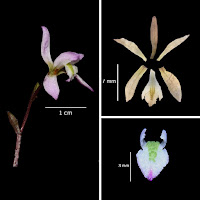 |
| Triphora gallegosii Figueroa, Zabalgoitia, Velázquez-R. & R. Jiménez, in Figueroa, Zabalgoitia, Velázquez-Ríos, Muñiz-Castro, Jiménez-Machorro, Guerrero-Hernández et Huerta-Galván, 2023. |
Abstract
Triphora gallegosii, a new species of geophyte orchid known so far from central, western, and northwestern Mexico, is described and illustrated. This species is morphologically similar to T. gentianioides and T. wagneri, with whom it shares the presence of scale-like leaves, three longitudinal verrucose lines on the lip, and floral parts of similar sizes, but differs from both by its lip lines that vanish towards the middle of the central lobe, having 1–4 resupinate flowers, and flowering between August and September. It also differs from T. wagneri by having a constricted central lobe and lateral lobes with acute apex, and from T. gentianoides by having entire margins on the lateral lobes, column with a magenta apex and whitish towards the middle portion with a green base, magenta anther, smaller leaves, and solitary growth. A preliminary analysis of the conservation status and a dichotomous key to the species of the genus in Mexico are provided.
Key words: Epidendroideae, geophyte, Monocot, taxonomy, terrestrial orchid
Triphora gallegosii Figueroa, Zabalgoitia, Velázquez-R. & R. Jiménez, sp. nov.
Triphora gallegosii is similar to T. gentianoides and T. wagneri in having lips with three longitudinal and verrucous lines, and in the size of floral parts. However, in T. gallegosii these lines vanish towards the middle of the central lobe (vs. reaching the apex of the central lobe), in addition, T. gallegosii has resupinate flowers (vs. non-resupinate). Furthermore, T. gallegosii differs from T. gentianoides in having 1–4 flowers (vs. 3–10 flowers), sepals and petals magenta at the apex, decreasing in intensity towards the middle portion and green at the base (vs. ranging from green to white, commonly with some brown or reddish tones on sepals), a white lip with a magenta spot at the tip of the central lobe (vs. white to pale green), green warts on the lip lines (vs. green and white warts), lateral lobes of the lip with entire margins (vs. erose to nearly lacerate), a column with a magenta apex and whitish towards the middle portion with a green base (vs. magenta to brown at the apex and the rest green or yellowish-white), a magenta anther (vs. yellow), leaves of 3.5–13 × 2–6 mm (vs. 10–18 × 5–10 mm), solitary growth habit (vs. growing in clusters), and blooming between August and September (vs. June and August). It also differs from T. wagneri in having 1–4 flowers (vs. 1 flower), lateral lobes constricted at their junction with the central lobe and with an acute apex (vs. unconstricted and obtuse), and blooming between August and September (vs. April).
Etymology:— This species is named after Dr. Jesús Guadalupe González-Gallegos, dear friend and researcher
of the CIIDIR herbarium who has contributed substantially to the floristic knowledge of western and northwestern
Mexico.
Dante S. Figueroa, Alejandro Zabalgoitia, Perla Velázquez-Ríos, Miguel Á. Muñiz-Castro, Rolando Jiménez-Machorro, Rolando Guerrero-Hernández and Oassis Huerta-Galván. 2023. A New Species of Triphora (Orchidaceae: Triphoreae, Triphorinae) from Mexico. Phytotaxa. 599(2); 89-99. DOI: 10.11646/phytotaxa.599.2.1
instagram.com/p/CtIe6r7uL4v






